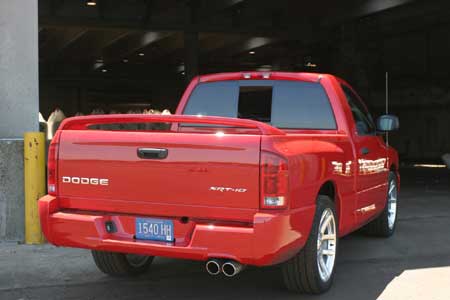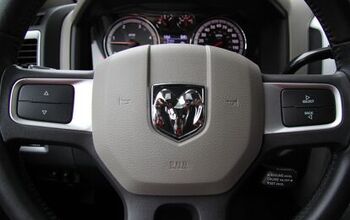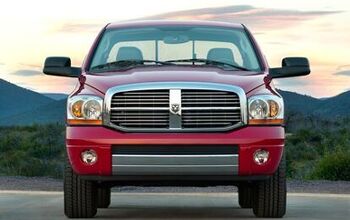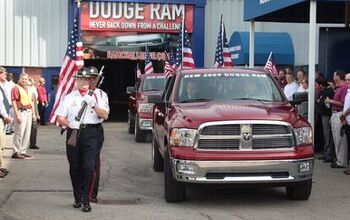Dodge Ram SRT-10 Review
Here's a question: why would anyone want a pickup truck that accelerates from 0 to 60 in 5.2 seconds? Don't most people prefer a flatbed that's comfortable or practical or reliable or fuel efficient or… something other than monstrously quick? What's the point of a Porsche-killing pickup?
Bragging rights. Drivers of the Dodge Ram SRT-10 bask in the knowledge that they're behind the wheel of the world's fastest pickup truck. And by God, they want everyone to know it. And by God, they will. Anyone who stands eyeball-to-eyeball with an SRT-10 will be in no doubt that The Dodge Boys' uber-pickup is in a league of its own.
The SRT-10's gigantic front spoiler, enormous grill and gargantuan hood (complete with "Viper powered" badges, bogus power bulge and fake air scoop) give the pickup all the charisma of a champion championship wrestler. One can only imagine the panic a steroidal Ram will cause steaming up to a Volvo driver's rear bumper.
Walk to the side and the 10's just another short bed pickup. Blame the ten-spokes. While the demi-bling wheels are the world's first factory-fitted 22's, they still can't fill the arches. They make the truck look small. Chrome exhausts the size of bean cans create the same illusion at the back. A gently arcing rear spoiler completes the Alice in Wonderland effect, while providing an important talking point. (Yes, you can detach the wing to load the bed.)
Hop aboard, and the sense of anticipation increases. At first glance, the interior is standard-issue truck: acres of slate grey plastic accented by rotary controls made from recycled hairbrush handles. And then you notice the sports seats, the oil temperature gauge set into the front pillar, the Hurst shifter and the white-on-black dials with 160 on the clock.
The starter button is, obviously, the main event. "Engine start" hooks you up to an 8.3-liter V10. Dodge has monkeyed around with the powerplant's internals– increasing the bore and stroke, fitting cast aluminum alloy pistons, that sort of thing. But it's basically the same 500hp mill that makes the Dodge Viper one of the scariest cars known to man. Strange then that the SRT-10 starts with a rental car's whine and instantly settles into a subdued rumble.
Once underway, the mighty machine's monster torque dominates. With 525ft.-lbs. of twist, you can lope along at the low end of any of the pickup's six gears. The steering rack, a modified version of the Ram Heavy Duty's rack-and-pinion system, allows for effortless slow-speed maneuvering, with a welcome touch of road feel.
The real action starts above 3000rpms. At that point, the SRT-10 gives you full access to its heavy metal soundtrack. Lift off the gas and the V10 thuds, pops and cackles like a '60's muscle car. Flex your right foot and damn it's loud. A Viper engine at full chat sounds like an endless bomb blast.
Max power clocks in at 5300rpms, making full-throttle acceleration a short but visceral event. Working the Tremec T56 gearbox to stay on song is no easy task. The throws are long and lack the necessary precision for quick, slick shifts. You also have to feather the go-pedal; lighting up the humongous Pirelli Scorpions in first, second or third gear is not only possible, it's probable.
Truth be told, an SRT-10 under full acceleration is brutal– and it's not just the neck-snapping G-forces. Over any surface rougher than a baby's backside, the SRT-10 jumps, hops, squirms and bucks. If you power the pickup around a bend with so much as a manhole cover obscuring your chosen line, you better be ready for some quick course correction. An irregular series of mid-corner bumps at anything above a jogging pace is a deeply unsettling experience– for all concerned.
No surprise there: the SRT-10 is a truck, with payload-friendly rear leaf suspension. The Dodge Boys have done everything in their power to try to overcome this limitation. They lowered the chassis, popped-in the mother of all truck axles (a Dana M60), devised new front and rear strut assemblies, installed a heavier rear sway bar, and so on. The result tracks well on smooth surfaces and rolls not a lot, but it still takes nerves of steel to corner this brute at speed. I supposed the fact that it corners at all is a major accomplishment, given the amount of horsepower involved.
The SRT-10 was never going to be both the fastest and the best handling truck. It was built for American buyers with a damn-the-mpg (it gets nine), straight-line mentality. Truck guys who love the fact that NASCAR driver Brendan Gaughan set the new pickup truck speed record (154.587mph). And guess what? He didn't even fold in the 10's side mirrors. For some people, that's all the reason they need to buy one.
More by Robert Farago
Latest Car Reviews
Read moreLatest Product Reviews
Read moreRecent Comments
- Kjhkjlhkjhkljh kljhjkhjklhkjh A prelude is a bad idea. There is already Acura with all the weird sport trims. This will not make back it's R&D money.
- Analoggrotto I don't see a red car here, how blazing stupid are you people?
- Redapple2 Love the wheels
- Redapple2 Good luck to them. They used to make great cars. 510. 240Z, Sentra SE-R. Maxima. Frontier.
- Joe65688619 Under Ghosn they went through the same short-term bottom-line thinking that GM did in the 80s/90s, and they have not recovered say, to their heyday in the 50s and 60s in terms of market share and innovation. Poor design decisions (a CVT in their front-wheel drive "4-Door Sports Car", model overlap in a poorly performing segment (they never needed the Altima AND the Maxima...what they needed was one vehicle with different drivetrain, including hybrid, to compete with the Accord/Camry, and decontenting their vehicles: My 2012 QX56 (I know, not a Nissan, but the same holds for the Armada) had power rear windows in the cargo area that could vent, a glass hatch on the back door that could be opened separate from the whole liftgate (in such a tall vehicle, kinda essential if you have it in a garage and want to load the trunk without having to open the garage door to make room for the lift gate), a nice driver's side folding armrest, and a few other quality-of-life details absent from my 2018 QX80. In a competitive market this attention to detai is can be the differentiator that sell cars. Now they are caught in the middle of the market, competing more with Hyundai and Kia and selling discounted vehicles near the same price points, but losing money on them. They invested also invested a lot in niche platforms. The Leaf was one of the first full EVs, but never really evolved. They misjudged the market - luxury EVs are selling, small budget models not so much. Variable compression engines offering little in terms of real-world power or tech, let a lot of complexity that is leading to higher failure rates. Aside from the Z and GT-R (low volume models), not much forced induction (whether your a fan or not, look at what Honda did with the CR-V and Acura RDX - same chassis, slap a turbo on it, make it nicer inside, and now you can sell it as a semi-premium brand with higher markup). That said, I do believe they retain the technical and engineering capability to do far better. About time management realized they need to make smarter investments and understand their markets better.






































Comments
Join the conversation
Clearly an answer to Ford's boosted Lightning, but likely the massive 8.3 V10 didn't cut it. It's not so street-friendly 4.11 gears do make it faster, but barely. Still, you were looking single digit city MPG. There was a lot of rivalry the street and strip so Lightning owners were cranking up their boost and easily getting the win. It just takes a few minute swap of the blower pulley. Those Dodge Boy weren't to happy about that nor the $12K extra they paid over a Lightning.